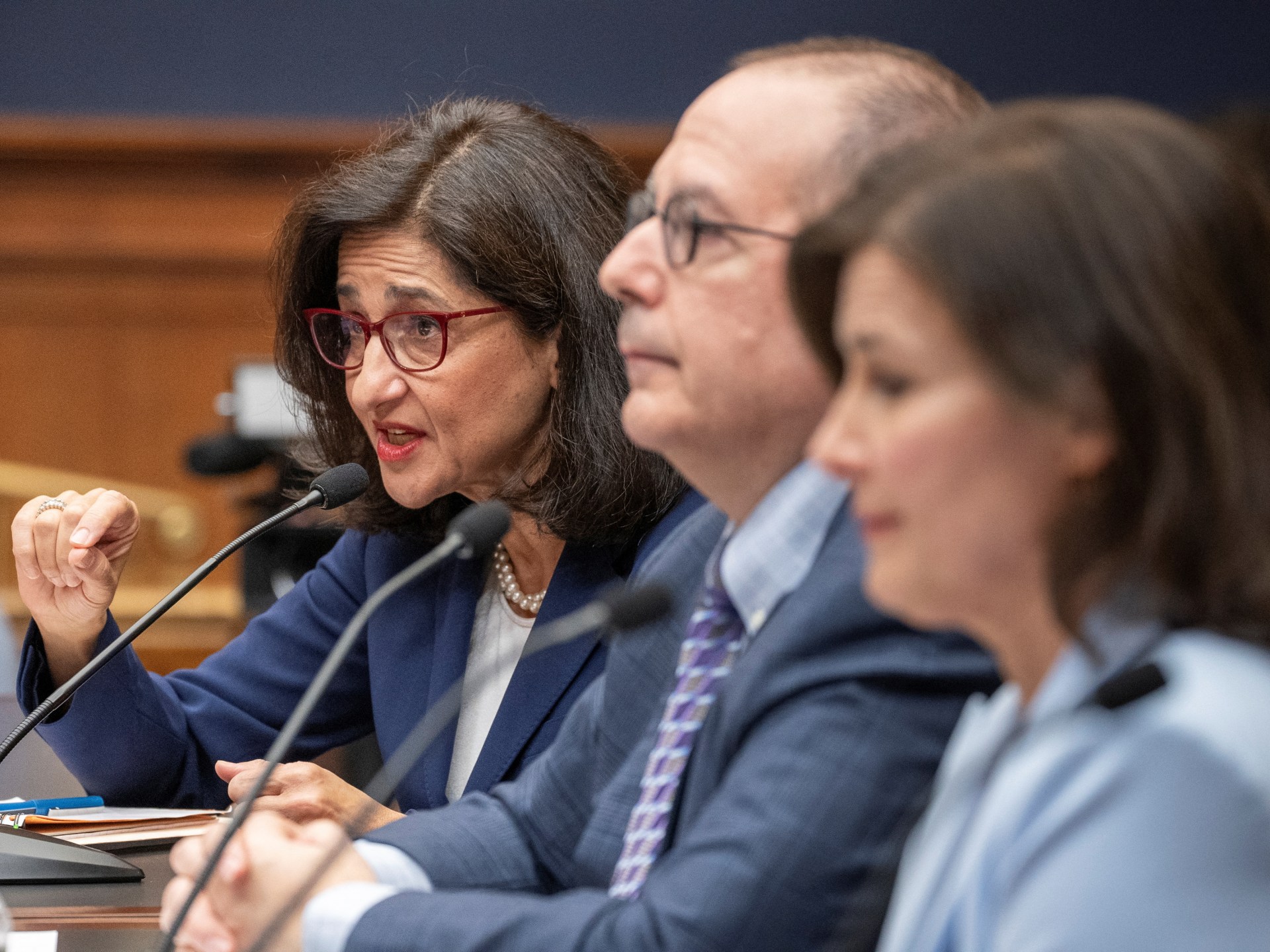Ecologist Daniel Janzen wades into the field, clutching a walking stick in one hand and a fist full of towering green blades of grass in the other to steady himself. Winnie Hallwachs, also an ecologist and Janzen’s wife, watches him closely, carrying a hat that she hands to him once he stops to explain our whereabouts.
Technology
Perplexity brings Yelp data to its chatbot
/cdn.vox-cdn.com/uploads/chorus_asset/file/25332455/pplx_map_preview_desktop.png)
Perplexity CEO Aravind Srinivas tells The Verge that many people are using chatbots like regular search engines. It makes sense to offer information on things they look for, like restaurants, directly from the source. So it’s integrating Yelp’s maps, reviews, and other details in responses when people ask for restaurant recommendations.
“Our underlying motivation is that we started off as this tool that appealed to people doing fact checks and research. But research can be on anything, like what if you’re a coffee addict, you’d want to know where the good coffee shops are,” says Srinivas.
As The Verge’s David Pierce recently pointed out, how Perplexity mixes text and links when answering questions was already a selling point compared to other chatbots like Copilot, Gemini, or ChatGPT. Srinivas says that consideration is part of why the company eventually chose Yelp. Srinivas says Yelp’s data allowed Perplexity to offer a variety of ways to provide answers, like adding maps, photos, or even quote reviews.
The responses include links to businesses’ Yelp pages so users can view more reviews or other details. Perplexity did not disclose the financial details of the deal and says it will not use Yelp’s data to train any model, as the company uses existing models like GPT and Claude 2 for the chatbot.
The connection is part of Yelp’s Fusion program licensing data to third parties, including BMW. “By integrating our highly trusted and rich local data into Perplexity, we’re able to provide their users with reliable local search results,” says Chad Richard, SVP of business & corporate development at Yelp, in an email to The Verge.
Perplexity is the latest AI company to cut a deal for a source of continually refreshed, up-to-date information, though Srinivas points out it is not partnering with Yelp but rather licensing its data. Google will reportedly pay Reddit $60 million a year to access real-time data and use Reddit data to train its AI models. OpenAI signed agreements with news publishers like Axel Springer to get data for training.
Other chatbots can also suggest cafes and restaurants, but much of this data comes from information models learned from the internet, almost like it did the searching for users. Some chatbots benefit from having access to services that already aggregate information on businesses. Google’s Gemini, for example, can give a list of restaurants when prompted complete with details like hours of operation, menus, and maps because it can pull from Google Maps.
Perplexity plans more integrations like this in the future, and it already works with the answer engine WolframAlpha for mathematical computations. Srinivas provided a few potential examples, like working providers of shopping data or financial data.

Technology
The Apple Vision Pro’s eBay prices are making me sad
/cdn.vox-cdn.com/uploads/chorus_asset/file/25255185/246965_vision_pro_VPavic_0001.jpg)
I paid a lot of money for the privilege of getting an Apple Vision Pro brand-new in February. All-in, with optical inserts and taxes, I financed a little over $3,900 for the 256GB version of the headset. A day or so ago, I made a mistake that I’m sure many early adopters are familiar with: I looked up how much it’s been selling for on eBay.
On Wednesday, a 1TB Vision Pro, complete with all the included gear, Apple’s fluffy $200 travel case, $500 AppleCare Plus, and claimed to have been “worn maybe about an hour” sold for $3,200 after 21 bids. The listed shipping estimate was $20.30. Brand new, that combination is $5,007.03 on Apple’s site for me. Another eBay listing, this one with my headset’s configuration (but sans optical inserts) went for just $2,600 — again with most, if not all, of the included accessories. Several other 256GB and 512GB models sold for around that amount this week.
This, of course, is how the story goes for early adopters, especially when you’re buying very expensive tech before the mainstream catches on. Apple’s pricing doesn’t help matters, especially when the next closest competing headset — the Meta Quest 3 — is just $500. It’s a bummer even if they’re ultimately not all that comparable, at least in terms of their targeted audiences and goals for their platforms.
But it still stings, doesn’t it? Knowing I could have saved several hundred dollars and gotten the highest storage configuration, AppleCare Plus, and a storage case is particularly painful. I like the Vision Pro plenty — maybe more than any other writer at The Verge — but if I hadn’t missed the return window, I would send mine right back to Apple in a heartbeat just so I could get one of these deals. Thankfully, when I’m wearing the headset, nobody can see my tears.
Technology
Put down your phone: How selfies and videos are ruining gym etiquette and invading privacy

Taking selfies and videos is now as common as sending emails or text messages. While taking selfies and videos in the comfort of your own home or in your own chosen company is a given, what about public spaces with strangers?
That’s a new world to navigate, as you now don’t only have to worry about “Big Brother” spying on you but also the stranger lifting weights or running on the treadmill next to you.
While a proud workout photo or video to post on social media or send to your friends or family to keep you motivated on your fitness journey is one thing, people are starting to film videos of themselves in group workout classes and all aspects of the gym experience.
CLICK TO GET KURT’S FREE CYBERGUY NEWSLETTER WITH SECURITY ALERTS, QUICK VIDEO TIPS, TECH REVIEWS AND EASY HOW-TO’S TO MAKE YOU SMARTER
Woman taking a selfie at the gym. (Kurt “CyberGuy” Knutsson)
Gyms tackle privacy in the age of social media
While gym rats may be comfortable with the ins and outs of gym culture and have a routine down pat, new members and private individuals alike who are already intimidated by stepping foot into the gym face the risk of being in some random person’s viral social media photo or video without their consent.
Though some influencers make a conscious effort to position their phones in an isolated way to photograph or tape only themselves or get permission from anyone else in the photo or video before posting, others capture people without their consent.
While hospitals and government buildings have started to post stronger “no cellphone” or “cellphone recording” policies, gyms, and workout studios are also starting to enact new policies to address the impact of selfies and videos.
MORE: UNFORGETTABLE MOTHER’S DAY GIFTS 2024

Man and woman doing yoga at yoga studio. (Kurt “CyberGuy” Knutsson)
MORE: 10 APPS THAT WILL HELP MAKE YOUR HEALTH RESOLUTIONS A REALITY
Top reasons why you should put the phone down at the gym
While a good workout selfie or video can feel like a personal post-workout reward, below are the top seven reasons why putting your phone down may be an even better reward:
1. Better focus: Unless you’re filming yourself working out to watch later to see how your form has changed over time, not having to worry about what angle to film or who is or isn’t in the shot helps you be more present during the workout. Not worrying about how you’re being filmed also likely helps you maintain better form.
2. Better results: Proper form and being engaged in your workout leads to better results.
3. Safer workout: Focusing helps you with better form for better results and keeps you safer. Anyone who’s done a squat incorrectly can attest to how important form is to getting results, not injuries. That split-second distraction from your phone can lead to chronic or acute pain later. It also creates a safer environment for others by limiting accidents.
FITNESS EXPERT SHARES 5 YOGA AND PILATES EXERCISES TO HELP RELEASE STRESS FROM YOUR BODY

Women giving each other a high-five during workout.
MORE: LOST WORKOUT DATA ON YOUR APPLE WATCH? HERE’S HOW TO MANUALLY LOG WORKOUTS
4. Better connection: It’s easy to scroll when there is a lag time between when you enter and start your workout class. But when you put the phone down before class, those few minutes can help you connect with yourself and those around you. You may not be paying attention to your energy levels if you’re busy focusing on taking a selfie or video before class or a cardio session. You could easily overdo it, which can lead you to “throw in the towel” too soon or not soon enough. You can miss connecting with the person next to you or the instructor giving key guidance.
5. Better experience: Most people don’t head to the gym to be reminded about all of life’s challenges, so why not shut off your phone and put those challenges at bay for the duration of your workout? The neighbor on the treadmill next to you likely doesn’t want to hear you complaining about work or your spouse. And to be honest, you probably don’t want to hear about their day, either.

Man checking his phone during a workout at the gym. (Kurt “CyberGuy” Knutsson)
MORE: APPLE WATCH VS FITBIT — WHICH REIGNS SUPREME FOR FITNESS?
6. Faster workout: Who hasn’t looked on their phone to check the time, only to be sucked into a time warp of notifications and other distractions? If you put down the phone, you’re likely to move through the different exercises faster. While resting intentionally between sets can be helpful for your body, taking selfies and recording videos may derail the momentum of your workout.
7. Protect your privacy and those around you: If you post “live” footage, photos or videos of you working out at the gym or a workout studio, you can leave yourself open to being targeted by unsavory individuals. If you must post, post after you leave the gym and mix up when you post so no one knows exactly where and when you work out. If you don’t care about others knowing your schedule, the person next to you might.
MORE: HOW TO STOP HEALTH AND FITNESS APPS FROM USING YOUR PRIVATE DATA
Kurt’s key takeaway
People have a lot of strong feelings about phones in workout spaces. While most aren’t trying to harass or intimidate those around them with what feels like an innocent workout selfie or video, some people are mocking other gym goers on social media — a terrible form of bullying that needs to be stopped. While some are looking for an escape from the perpetual feeling of being observed and potentially recorded, some gym goers say having a camera recording their workouts makes them feel safer when the gym is empty, or they’re working out alone.
You should absolutely be proud of keeping fit in your workout spaces. While documenting your progress can be a healthy part of it, it is important to be mindful of when, where, and with whom you are doing it. Who knows? Maybe not documenting every workout can create a better workout experience for yourself.
Do people filming their workouts bother you? Why or why not? Let us know by writing us at Cyberguy.com/Contact
For more of my tech tips & security alerts, subscribe to my free CyberGuy Report Newsletter by heading to Cyberguy.com/Newsletter
Ask Kurt a question or let us know what stories you’d like us to cover.
Answers to the most-asked CyberGuy questions:
Copyright 2024 CyberGuy.com. All rights reserved.
Technology
They turned cattle ranches into tropical forest — then climate change hit
/cdn.vox-cdn.com/uploads/chorus_asset/file/25249712/246961_Costa_Rica_Renewables_2_IVargas.jpg)
Together with other conservationists who have dedicated decades of their lives to this place, the couple has brought forests back to the Area de Conservación Guanacaste (ACG). It’s an astonishing 163,000 hectares of protected landscapes — an area larger than the Hawaiian island of Oahu — where forests have reclaimed farmland in Costa Rica.
The grass isn’t supposed to be here. Janzen and Hallwachs only keep this small field around as a reminder of — and to show visitors like me — how far they’ve come since the 1970s, when pastures and ranches still dominated much of the landscape.
Across from the field, on the other side of a two-lane road that winds through the ACG, is one of the first stretches of young forest that Janzen and Hallwachs started nursing back to life. Tree limbs stretch out over the road, as if trying to reach the remaining patch of grass left to seed on the other side.
“This is just weird.”
ACG is a success story, a powerful example of what can happen when humans help forests heal. It’s part of what’s made Costa Rica a destination for ecotourism and the first tropical country in the world to reverse deforestation. But now, the couple’s beloved forest faces a more insidious threat.
Across the road, the leaves are too perfect. It’s like they’re growing in a greenhouse, Janzen says. There’s an eerie absence among the foliage — although you’d probably also have to be a regular in the forest to notice.
“Every year it seems worse,” Hallwachs says. “We should have found bugs.”
There should have been bees, wasps, and moths along our walk, she explains. And plenty of caterpillar “houses” — curled up leaves the critters sew together that eventually become shelter for other insects. “The houses were everywhere, now it’s almost exciting when you see one,” Hallwachs says. “This is just weird.”
The bugs play crucial roles in the forest — from pollinating plants to forming the base of the food chain. Their disappearance is a warning. Climate change has come to the ACG, marking a new, troubling chapter in the park’s comeback story.
It also serves as a lesson for conservation efforts around the globe. More than 190 countries have recently committed to restoring 30 percent of the world’s degraded ecosystems under the Kunming-Montreal Global Biodiversity Framework. Billionaire philanthropists are pledging to support those efforts. What’s happening here in the ACG says a lot about what it takes to revive a forest — especially in a warming world.
“When I was here earlier, a younger person, I could win a case of beer by betting on the first day that the rains would start,” Janzen tells The Verge. Now, at 85 years old, he says, “I would never dream of betting anything because it can start a month early or a month late.”
The dry season is about two months longer than it was when Janzen arrived in the 1960s. Climate change is making seasons more unpredictable and weather more erratic across the planet. And that’s posing new risks to the sanctuary scientists like Janzen and Hallwachs have created at ACG.
María Marta Chavarría, ACG’s field investigation program coordinator, describes the unpredictability as “el alegrón de burro.” Strictly translated from Spanish, it means “donkey happiness.” Colloquially, it describes a fake-out: short-lived joy from a false start.
Chavarría, who speaks with the upbeat tilt of an educator excited to teach, explains it like this, “A big rain is the trigger. It’s time! The rainy season is going to start!” Trees unfurl new leaves. Moths and other insects that eat those leaves emerge. But now, the rains don’t always last. The leaves die and fall. That has ripple effects across the food chain, from the insects that eat the leaves to birds that eat the insects. They perish or move on. And next season, there are fewer pollinators for the plants. “The big trigger in the beginning was false,” Chavarría explains. “They started, but no more.”
In 1978, Janzen jumped down a ravine because he was “young and carefree and just 40 years old,” in his words. Slipping on wet rocks, he broke three ribs. While recuperating, he spent a month sitting outside of his home on the edge of the forest in the evenings. Next to a 25-watt light bulb outside, the “front wall was literally plastered with adult moths,” he recalls in a 2021 paper he and Hallwachs published in the journal PNAS. The title was “To us insectometers, it is clear that insect decline in our Costa Rican tropics is real, so let’s be kind to the survivors.”
That observation in 1978 led the couple to focus their research on caterpillars and their parasites. In 1980, they used light traps to inventory moth species across the country, documenting at least 10,000 species. Since then, however, they’ve seen a steady decline in caterpillars whose feces used to blanket the forest floor.
Hanging a white sheet and lights at the edge of a cliff overlooking a vast stretch of both old and new-growth forests, they photographed moths that came to rest on the sheet in 1984, 1995, 2007, and 2019. The first photograph is an impressive tapestry of many different winged critters. By 2019, that’s been reduced to a mostly white sheet speckled here and there with far fewer moths. Instead of an intricate tapestry of wings and antennae, the sheet looks more like a blank canvas an artist has only started to splatter with a brush.
Hallwachs and Janzen can see the same phenomenon now standing in broad daylight in the forest across from the field. Just because forests have come roaring back across the ACG doesn’t mean the struggle to survive is over.
1/3
How to turn a ranch into a forest
In a roundabout way, butterflies brought Janzen to Guanacaste. A ninth-grade trip to collect butterflies in Mexico sparked his love of tropical ecosystems in the 1950s. He returned to Veracruz, Mexico, as a PhD student a decade later, collecting insects for a research project. Guanacaste is biologically similar to Veracruz, Janzen says — filled with tropical dry forests. The parallels brought him to Costa Rica in 1963 to research interactions between plants and animals.
Compared to rainforests that have cafes and even an e-commerce giant named after them, dry forests arguably aren’t in the spotlight so much. And yet they’re disappearing faster across Latin America than their rainier counterparts. Dry forests are less humid and a little more hospitable to people and agriculture, so people came to raze them. In Costa Rica, which exported as much as 60 percent of its beef to Burger King at one point, ranches and pastures replaced forests. Grasses, good for cows, grew in their place. Between 1940 and 1990, forest cover in Costa Rica shrank from 75 to just 29 percent.
Another American conservationist, Kenton Miller, first envisioned a national park in Guanacaste in 1966. Commissioned by the Costa Rican government to plan a national monument to one of the country’s oldest ranches in the area, he instead made the case for preserving a stretch of Guanacaste’s remaining, albeit damaged, dry forest. The aim was to protect 10,400 hectares of land that’s now the Parque Nacional Santa Rosa. And Miller wanted to do more. Park staff still quote him saying his “dream was the creation of a national park that would stretch from the sea to the peaks of mountains and volcanoes.”
Janzen was ambling around the area around the same time, albeit more focused on research than conservation. “I studied it, they saved it,” he wrote in 2000. Hallwachs joined him as a volunteer research assistant in 1978, and the two married soon after.
In Santa Rosa, Hallwachs studied agoutis, rodents that can get to be about as big as domestic cats. She devised an ingenious way to study how the animals disperse seeds throughout the forest, Janzen boasts proudly, by placing a bobbin of thread inside the thick-skinned fruit of the guapinol tree that agoutis bury to eat later.
The nature of their work started to change in 1985 after a trip to study Australia’s dry forests. There, they saw how ranchers’ fires had caused so much devastation over the years that even some biologists had no idea that what they saw as grass plains were really overgrown pastures that used to be forest. They realized that fires could do the same in Guanacaste, as long as the grass remained.
The problem is sometimes called the human-grass-fire cycle: when invasive grasses, often introduced through agriculture, crowd out forests and then dry out and become fuel, making the landscape more fire-prone. It’s a threat in a lot of places outside of Costa Rica, contributing to the devastating fire that tore through Maui last year.
In Guanacaste, ranchers had wielded fire since the 1600s to keep the forest at bay, preventing it from creeping back into pastures. If Santa Rosa was to survive, fires and invasive grasses would have to go. The national park would also need to grow with the support of the local community.
The couple drafted a plan to expand Santa Rosa into a larger conservation area, enlisting residents’ help in stamping out fires and even hiring former ranch hands to form a firefighting crew. Over 30 years, the initiative to create ACG raised enough money to buy more than 350 surrounding farms and ranches. Serendipitously, by the 1990s, declining international beef prices and a landmark forest law that outlawed deforestation and paid people to protect natural resources also served to transform the landscape across Costa Rica.
It’s a victory that, lately, has been in the shadow of splashy commitments by influencers, billionaires, and policymakers to plant a ton of trees. It’s become a popular way for companies and consumers to try to offset some of their environmental footprint. “We see all the hype coming from people who are going to plant a billion trees and nobody gives us any credit,” Janzen laments. What’s worse, a lot of those corporate tree-planting campaigns are fundamentally flawed.
The first seeds blew in with the wind
“A lot of the reforestation projects are kind of assuming that trees are mechanical objects,” Hallwachs says. But they don’t stand alone, not in a healthy forest.
Merely plant rows of trees, and the result is a tree plantation — not a forest. Bringing back a forest is a much different endeavor. It’s more about restoring relationships — reconnecting remaining forests with land that’s been cleared and nurturing new kinds of connections between people and the land.
In ACG’s dry forest, they didn’t have to plant trees by hand. By getting rid of the grass and stopping the fires, they cleared the way for the forest’s return. The first seeds blew in with the wind.
Hallwachs and Janzen recognize them like old friends — stopping next to a Dalbergia tree that was one of the first to grow where they stomped out the fires. Its seeds are light and flat, allowing them to float on a breeze. When those trees start to grow, they attract animals in search of food or shelter.
Janzen measures each animal up by how many seeds they can hold and then spit or defecate onto the forest floor. “When you see a bird fly by, what you’re seeing is a tablespoon full of seeds,” he says. “Every deer you see is a liter of seeds.”
Now, ACG is estimated to hold as many as 235,000 different terrestrial species — representing around 2.6 percent of global biodiversity. For comparison, Costa Rica as a whole holds roughly 4 percent of the world’s biodiversity, home to more species than the US and Canada combined. The ACG is now a world heritage site spanning not just dry forest but nearby rainforest, cloud forest, and marine ecosystems.
The forest across the field is considered “secondary.” In other words, it’s not the original forest; it’s one that’s grown back after being cleared. Today, more than 75 percent of the country is blanketed by forest, and more than half of that canopy is young secondary forest. It plays a critical role in protecting biodiversity, giving threatened species a home and slowing climate change by absorbing carbon dioxide from the atmosphere.
It’s also where the couple has built a humble home nestled under a secondary canopy. They spend three months at a time here, bouncing back and forth between Guanacaste and Philadelphia, where Janzen is a professor of biology emeritus and Hallwachs is a research biologist at the University of Pennsylvania.
The front porch is a couple of plastic lawn chairs on the forest floor, shaded by corrugated metal. A web of clotheslines hangs from wooden rafters inside, clothespins securing bags of plants and other specimens they’ve collected over the years. Somewhere among the glass jars and more plastic bags on Janzen’s desk, he fishes out a wooden bobbin like those that his wife used to track agoutis’ movements by following threads along the forest floor. Now, there’s an agouti foraging outside the front door the couple keeps open to the forest.
“There was a time when we thought [agoutis] would never show up at our house because our house was in the pasture. It was so far away from all of this,” Janzen recalls. “Today, they’re there every morning.”
“The living dead”
A short drive from Janzen and Hallwachs’ home, along a stretch of the winding paved road through the ACG, the tree canopy seems to close in overhead. With the windows rolled down, you can smell the shift to musty, moist earth. Stop and step outside, and the forest floor is darker, spongier. The thick foliage above filters out more sunlight; more of those leaves have accumulated and decayed on the ground for centuries without burning. In other parts of the park, Janzen can bring his walking stick down with a thud, hitting harder, more compact soil. Here, his walking stick rustles through layers of leaf litter.
“You’re standing in the only piece of original dry forest between Brownsville, Texas, and the Panama Canal [along] a paved road,” Janzen says.
This 22-hectare sprawl, just half as big as the Mall of America, is a gem in the ACG. It’s the source of seeds that blew into old pastures. In an ideal world — with several more centuries and a stable climate — primary forests like this might have grown to infiltrate the secondary forests it now has as neighbors. In other words, more of the ACG might look and feel like this original forest.
“The intent was always that. Then comes climate change,” Hallwachs says.
While it’s hotter and drier in this part of the world because of climate change, it’s noticeably cooler in the original forest than in areas nearby that have been razed. It’s another benefit of the old evergreen trees towering overhead. Janzen leads us to a 300-year-old tree. The common name for it, he explains, is chicle — the Spanish word for chewing gum, which can be made from the white latex under its bark.
We visit another ancient tree, the guapinol. Amber jewelry is made from its fossil resin. Its seeds are the same ones the agouti bury across the forest. “And that’s how the forest moves,” Janzen says.
But the last time the tree bore fruit was about 25 years ago. For a tree that only flowers every quarter-century, everything needs to be just right for it to successfully reproduce — enough water and nutrients and plenty of pollinators (in the guapinol’s case, bats). If that doesn’t happen, you could lose the next generation. Here in the ACG, the guapinol is one of what Hallwachs and Janzen call “the living dead.”
“The climate for their successful reproduction has already moved on,” Hallwachs says. “So what will be here in 25 years? We are very much hoping there will be forest in 25, 50 years. But there will be some of these classic species that won’t be able to make it.”
This is what gives me hope
The forest is changing faster than Janzen, Hallwachs, and other researchers can document. There’s not much to do about it except to stop climate change and deforestation, they say, and keep on with their work of restoring the landscape. The ACG’s other ecosystems have suffered from climate change, too — from coral reefs losing their color in the heat to cloud forests losing their clouds.
“At this point in time and budgets, ACG does not require more classical academic scientific study of climate change impacts,” they wrote in their 2021 PNAS article. “Confronted with a metaphorical burning house today in the tropics, the critical priority is the complex of fire departments, fire codes, fire alarms, fire exits, emergency rooms for burn victims, and rules and views that prohibit candles in Christmas trees, rather than for more and fancier thermometers.”
Scrolling through photos of ACG’s coral reef bleaching last year, Chavarría tells The Verge, “This is really hard for me being here, documenting this. Sometimes I want to cry.” The water was so hot it felt like jumping into soup. Under stress, corals expel the algae that give them their color and energy. If the bleaching lasts too long, the corals could die.
She’s tried to get funding to restore the reef and figure out which corals could be more resilient to climate change but hasn’t had luck yet, she says. Still, she believes they can be saved. “This is what gives me hope,” she says, pointing to a colony of coral that didn’t bleach. It’s still pink. This is what conservationists should pay attention to, she says, her voice still upbeat.
When things get rough, Chavarría heads to a lookout point where she can see the hectares of forest below that she’s helped to revive. It reminds her of what’s possible.
There is still hope and growth in Guanacaste. The ACG team’s restoration efforts are expanding outside of its official borders. Working with local women on a former salt flat, Chavarría is restoring a coastal mangrove forest, which has proven to be even more effective at storing carbon dioxide than other kinds of forests of the same size, keeping the greenhouse gas from further heating the planet. Thick mangrove roots also grip the earth so tightly that they can protect coastlines from rising seas and erosion.
The project is also expected to improve fishing prospects for residents who depend on it for food and livelihood. That kind of community buy-in to the forests’ survival has been one of the pillars of ACG since its inception. Officially, they call it biodesarrollo, or biodevelopment. In practice, it’s relationship-building. Chavarría started a program for kids in a local fishing town, taking them snorkeling to learn more about the ocean ecosystem. She remembers one of the very first kids in the program jumping out of the water, screaming, “María, they are colorful!” Before that moment, she says, “These kids know the fish just fried in the pan, never alive in the reef.” The program got mothers in town curious and, now, more involved in projects like restoring the mangrove forest.
It’s tough work, planting seedlings along newly dug canals while your boots sink into brackish mud. But they won’t have to plant too many trees — just enough to stabilize water canals that bring back the natural ebb and flow of the tide to this former salt flat. Each tide washes away layers of salt, picks up seedlings from surviving mangrove trees nearby, and deposits them here to grow.
Photography by Justine Calma / The Verge
The International Center for Journalists supported this reporting, and Punto y Aparte contributed to the report.
-

 Movie Reviews1 week ago
Movie Reviews1 week agoMovie Review: The American Society of Magical Negroes
-

 World1 week ago
World1 week agoIf not Ursula, then who? Seven in the wings for Commission top job
-

 Kentucky1 week ago
Kentucky1 week agoKentucky first lady visits Fort Knox schools in honor of Month of the Military Child
-

 World1 week ago
World1 week agoColumbia University leaders face scrutiny over anti-Semitism on campus
-

 News1 week ago
News1 week agoHouse passes bill requiring warrant to purchase data from third parties
-

 Politics1 week ago
Politics1 week agoTrump trial: Jury selection to resume in New York City for 3rd day in former president's trial
-

 Politics1 week ago
Politics1 week agoFormer Wisconsin Democratic Rep. Peter Barca launches congressional comeback bid
-

 World1 week ago
World1 week agoEU leaders weigh Lebanon partnership in response to Middle East crisis












